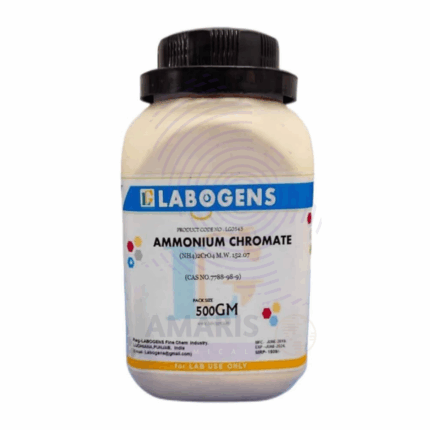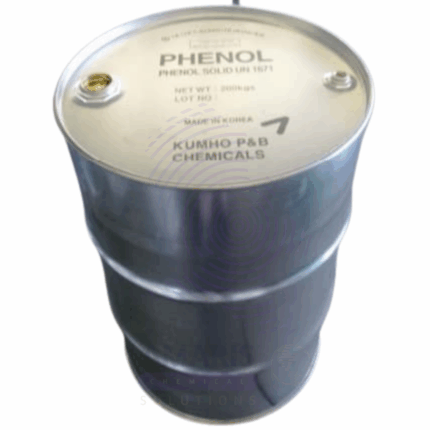
Ammonium Cupric Chloride Extra Pure
- SHORT DESCRIPTION
Ammonium Cupric Chloride Extra Pure is a high-purity, greenish-blue crystalline compound composed of ammonium and copper(II) ions combined with chloride. It is primarily used in laboratory chemistry for etching, electroplating studies, and as a reagent in qualitative analysis and coordination chemistry. This compound is particularly valuable in experiments involving complex ion formation and redox behavior of transition metals. Its extra pure grade ensures high consistency and low levels of interfering impurities, supporting precise analytical and research work. Due to its sensitivity to light and moisture, it should be stored in tightly sealed, opaque containers in a cool, dry environment to maintain stability and reactivity.
- USES
Primary Uses
- Reagent in Coordination Chemistry
- Used to study complex ion formation, particularly copper(II) coordination with chloride ligands.
- Demonstration of Ligand Field & Color Chemistry
- Exhibits intense blue-green color, useful in teaching ligand field theory and d–d electron transitions in transition metal complexes.
- Source of Cu²⁺ Ions in Analytical Chemistry
- Supplies cupric ions in qualitative tests involving precipitation, complexation, or redox reactions.
- Catalyst Precursor in Experimental Synthesis
- Investigated as a source of copper in catalytic systems for oxidation or coupling reactions at lab scale.
- Model Compound in Crystallography and Solid-State Chemistry
- Used for studying crystal structures, lattice geometry, and isomerism of transition metal complexes.
Secondary Uses
- Electrochemical Research on Cu(II) Complexes
- Employed in voltammetric and redox studies of copper coordination systems.
- Preparation of Thin Films or Nanostructures (Experimental Use)
- Used in exploratory research on copper-based materials for optics or electronics.
- Comparative Solubility and Precipitation Studies
- Helps demonstrate the solubility behavior of complex salts in ionic strength and pH-dependent systems.
- Inorganic Teaching Labs
- Ideal for student synthesis experiments involving double salts and transition metal complexes.
- Study of Thermal Decomposition Pathways
- Decomposes to copper oxides and ammonium salts, used in thermogravimetric and decomposition studies.
KEY ATTRIBUTES
1. Basic Identification Attributes
- Chemical Name: Ammonium Cupric Chloride
- CAS Number: 10377-22-9 (for ammonium tetrachlorocuprate(II)), commonly used form
- HS Code: 28273900 (Other copper chlorides)
- Molecular Formula: (NH₄)₂CuCl₄
- Synonyms:
- Ammonium tetrachlorocuprate(II)
- Diammonium tetrachlorocuprate
- Cupric ammonium chloride
- Tetrachlorocuprate(II) ammonium salt
2. Physical & Chemical Properties
- Physical State: Solid (crystalline or powder)
- Color & Odor: Green to blue-green crystals; odorless
- Boiling Point: Decomposes before boiling
- Melting Point: Decomposes on heating
- Density/Specific Gravity: ~2.1–2.3 g/cm³
- Solubility:
- Water: Freely soluble (forms deep blue or green solution)
- Alcohol: Slightly soluble
- pH Level: ~3.5–5.5 (5% solution; acidic)
- Vapor Pressure: Negligible
- Flash Point: Not flammable
- Autoignition Temperature: Not applicable
- Viscosity: Not applicable
3. Safety & Hazard Attributes
- Hazard Class (GHS):
- Acute Toxicity – Oral & Inhalation (Category 4)
- Eye Irritation (Category 2A)
- Skin Irritation (Category 2)
- Environmental Hazard – Aquatic Acute & Chronic (Category 1)
- NFPA Ratings:
- Health: 2
- Flammability: 0
- Reactivity: 0
- Exposure Limits:
- No specific limits for this salt
- Use general limits for copper compounds:
- OSHA PEL: 1 mg/m³ (as Cu dust and mist)
- ACGIH TLV: 0.2 mg/m³ (fume), 1 mg/m³ (dust/mist)
- Reactivity:
- Stable under normal lab conditions
- Incompatible with strong acids and reducing agents
4. Storage & Handling Attributes
- Storage Conditions:
- Store in a cool, dry place away from light and incompatible substances
- Incompatible Materials:
- Strong acids, strong reducing agents, cyanides
- Container Type:
- Plastic or amber glass containers, tightly sealed
- Shelf Life & Expiration Date:
- 2–3 years in sealed containers under proper conditions
- Special Handling Requirements:
- Use gloves and goggles
- Handle in a fume hood to avoid inhalation of any dust or vapors during solution preparation
5. Regulatory & Compliance Attributes
- Regulatory Status:
- Listed under TSCA (components), REACH
- Regulated as a hazardous substance due to copper and chloride content
- Transportation Restrictions:
- Not regulated in small lab quantities
- Waste Disposal Method:
- Dispose as hazardous waste
- Avoid introducing copper salts into drains due to aquatic toxicity
6. Environmental & Health Impact
- Ecotoxicity:
- Highly toxic to aquatic organisms, even at low concentrations
- Persistence in Environment:
- Copper ions persist in soil and sediments
- Carcinogenicity/Mutagenicity:
- Not classified as carcinogenic
- Biodegradability:
- Inorganic compound; not biodegradable
SAFETY PRECAUTIONS
- Personal Protective Equipment (PPE):
- Wear a lab coat, safety goggles, and chemical-resistant gloves (e.g., nitrile or neoprene).
- Use a fume hood or ensure good room ventilation to avoid inhalation of any dust or fumes.
- Handling:
- Handle with care—toxic if ingested or inhaled, and irritant to skin and eyes.
- Avoid formation and inhalation of dust.
- Do not allow contact with incompatible materials (e.g., strong bases, oxidizers, or reducing agents).
- Storage:
- Store in a tightly sealed container in a cool, dry, well-ventilated area.
- Protect from moisture and direct sunlight.
- Label clearly and store away from acids and combustible materials.
- Hygiene Measures:
- Wash hands thoroughly after handling.
- Do not eat, drink, or smoke in lab areas.
- Clean spills promptly and dispose of waste properly.
FIRST AID MEASURES
- Inhalation:
- Move person to fresh air immediately.
- If breathing is difficult, administer oxygen and seek medical attention.
- May cause irritation to respiratory tract.
- Skin Contact:
- Remove contaminated clothing.
- Wash skin thoroughly with soap and water.
- Seek medical attention if irritation or a rash develops.
- Eye Contact:
- Rinse eyes cautiously with clean water for at least 15 minutes.
- Keep eyelids open during rinsing.
- Seek immediate medical attention, especially if irritation persists.
- Ingestion:
- Rinse mouth thoroughly with water.
- Do not induce vomiting unless directed by medical personnel.
- Give water if the person is conscious.
- Seek immediate medical attention — copper salts can cause nausea, vomiting, abdominal pain, and systemic toxicity.
FIRE FIGHTING MEASURES
- Suitable Extinguishing Media:
- Use dry chemical, carbon dioxide (CO₂), foam, or water spray, depending on the surrounding materials.
- Specific Hazards:
- Not flammable, but may release toxic and corrosive fumes (including hydrogen chloride, ammonia, and copper oxides) when heated.
- Avoid breathing vapors or smoke from decomposition.
- Protective Equipment for Firefighters:
- Wear full protective gear and a self-contained breathing apparatus (SCBA).
- Firefighting Instructions:
- Evacuate area and fight fire from a safe distance.
- Cool containers with water spray.
Avoid water runoff contamination—harmful to aquatic life.


 Preservatives(food)
Preservatives(food) Flavor Enhancers
Flavor Enhancers Acidulants
Acidulants Sweeteners
Sweeteners Antioxidants
Antioxidants Colorants(food)
Colorants(food) Nutraceutical Ingredients (food)
Nutraceutical Ingredients (food) Nutrient Supplements
Nutrient Supplements Emulsifiers
Emulsifiers
 Collectors
Collectors Dust Suppressants
Dust Suppressants Explosives and Blasting Agents
Explosives and Blasting Agents Flocculants and Coagulants
Flocculants and Coagulants Frothers
Frothers Leaching Agents
Leaching Agents pH Modifiers
pH Modifiers Precious Metal Extraction Agents
Precious Metal Extraction Agents
 Antioxidants(plastic)
Antioxidants(plastic) Colorants (Pigments, Dyes)
Colorants (Pigments, Dyes) Fillers and Reinforcements
Fillers and Reinforcements Flame Retardants
Flame Retardants Monomers
Monomers Plasticizers
Plasticizers Polymerization Initiators
Polymerization Initiators Stabilizers (UV, Heat)
Stabilizers (UV, Heat)
 Antifoaming Agents
Antifoaming Agents Chelating Agents
Chelating Agents Coagulants and Flocculants
Coagulants and Flocculants Corrosion Inhibitors
Corrosion Inhibitors Disinfectants and Biocides
Disinfectants and Biocides Oxidizing Agents
Oxidizing Agents pH Adjusters
pH Adjusters Scale Inhibitors( water)
Scale Inhibitors( water)
 Antioxidants(cosmetic)
Antioxidants(cosmetic) Emollients
Emollients Fragrances and Essential Oils
Fragrances and Essential Oils Humectants
Humectants Preservatives
Preservatives Surfactants(cosmetic)
Surfactants(cosmetic) Thickeners
Thickeners UV Filters
UV Filters
 Fertilizers
Fertilizers Soil Conditioners
Soil Conditioners Plant Growth Regulators
Plant Growth Regulators Animal Feed Additives
Animal Feed Additives Biostimulants
Biostimulants Pesticides (Herbicides, Insecticides, Fungicides)
Pesticides (Herbicides, Insecticides, Fungicides)
 Active Pharmaceutical Ingredients (APIs)
Active Pharmaceutical Ingredients (APIs) Excipients
Excipients Solvents(pharmaceutical)
Solvents(pharmaceutical) Antibiotics
Antibiotics Antiseptics and Disinfectants
Antiseptics and Disinfectants Vaccine Adjuvants
Vaccine Adjuvants Nutraceutical Ingredients (pharmaceutical)
Nutraceutical Ingredients (pharmaceutical) Analgesics & Antipyretics
Analgesics & Antipyretics
 Analytical Reagents
Analytical Reagents Solvents(lab)
Solvents(lab) Chromatography Chemicals
Chromatography Chemicals Spectroscopy Reagents
Spectroscopy Reagents microbiology-and-cell-culture-reagents
microbiology-and-cell-culture-reagents Molecular Biology Reagents
Molecular Biology Reagents Biochemical Reagents
Biochemical Reagents Inorganic and Organic Standards
Inorganic and Organic Standards Laboratory Safety Chemicals
Laboratory Safety Chemicals Specialty Laboratory Chemicals(Special Laboratory Equipment)
Specialty Laboratory Chemicals(Special Laboratory Equipment)
 Demulsifiers
Demulsifiers Hydraulic Fracturing Fluids
Hydraulic Fracturing Fluids Scale Inhibitors(oil)
Scale Inhibitors(oil) Surfactants(oil)
Surfactants(oil) Drilling Fluids
Drilling Fluids
 Dyes and Pigments
Dyes and Pigments Bleaching Agents
Bleaching Agents Softening Agents
Softening Agents Finishing Agents
Finishing Agents Antistatic Agents
Antistatic Agents
 Admixtures
Admixtures Waterproofing Agents
Waterproofing Agents Sealants and Adhesives
Sealants and Adhesives Curing Compounds
Curing Compounds Concrete Repair Chemicals
Concrete Repair Chemicals Anti-Corrosion Coatings
Anti-Corrosion Coatings
 Surfactants(cleaning)
Surfactants(cleaning) Builders
Builders Enzymes
Enzymes Solvents (Cleaning)
Solvents (Cleaning) Fragrances
Fragrances
 Electronic Chemicals
Electronic Chemicals Catalysts
Catalysts Lubricants
Lubricants Photographic Chemicals
Photographic Chemicals Refrigerants
Refrigerants Automotive chemicals
Automotive chemicals Pyrotechnic Chemicals
Pyrotechnic Chemicals
 Biodegradable Surfactants
Biodegradable Surfactants Bio-based Solvents
Bio-based Solvents Renewable Polymers
Renewable Polymers Carbon Capture Chemicals
Carbon Capture Chemicals Wastewater Treatment Chemicals
Wastewater Treatment Chemicals
 Pigments
Pigments Solvents(paint)
Solvents(paint) Specialty Coatings
Specialty Coatings Binders/Resins
Binders/Resins Additives
Additives Driers
Driers Anti-Corrosion Agents
Anti-Corrosion Agents Functional Coatings
Functional Coatings Application-Specific Coatings
Application-Specific Coatings
 Fresh Herbs
Fresh Herbs Ground Spices
Ground Spices Whole Spices
Whole Spices Spice Blends
Spice Blends Dried Herbs
Dried Herbs
 Leavening Agents
Leavening Agents Dough Conditioners
Dough Conditioners Flour Treatments
Flour Treatments Fat Replacers
Fat Replacers Decoratives
Decoratives Preservatives(baking)
Preservatives(baking)
 Plasticizers & Softeners
Plasticizers & Softeners Reinforcing Agents
Reinforcing Agents Adhesion Promoters
Adhesion Promoters Vulcanizing Agents
Vulcanizing Agents Antidegradants
Antidegradants Blowing Agents
Blowing Agents Fillers & Extenders
Fillers & Extenders Accelerators & Retarders
Accelerators & Retarders


















